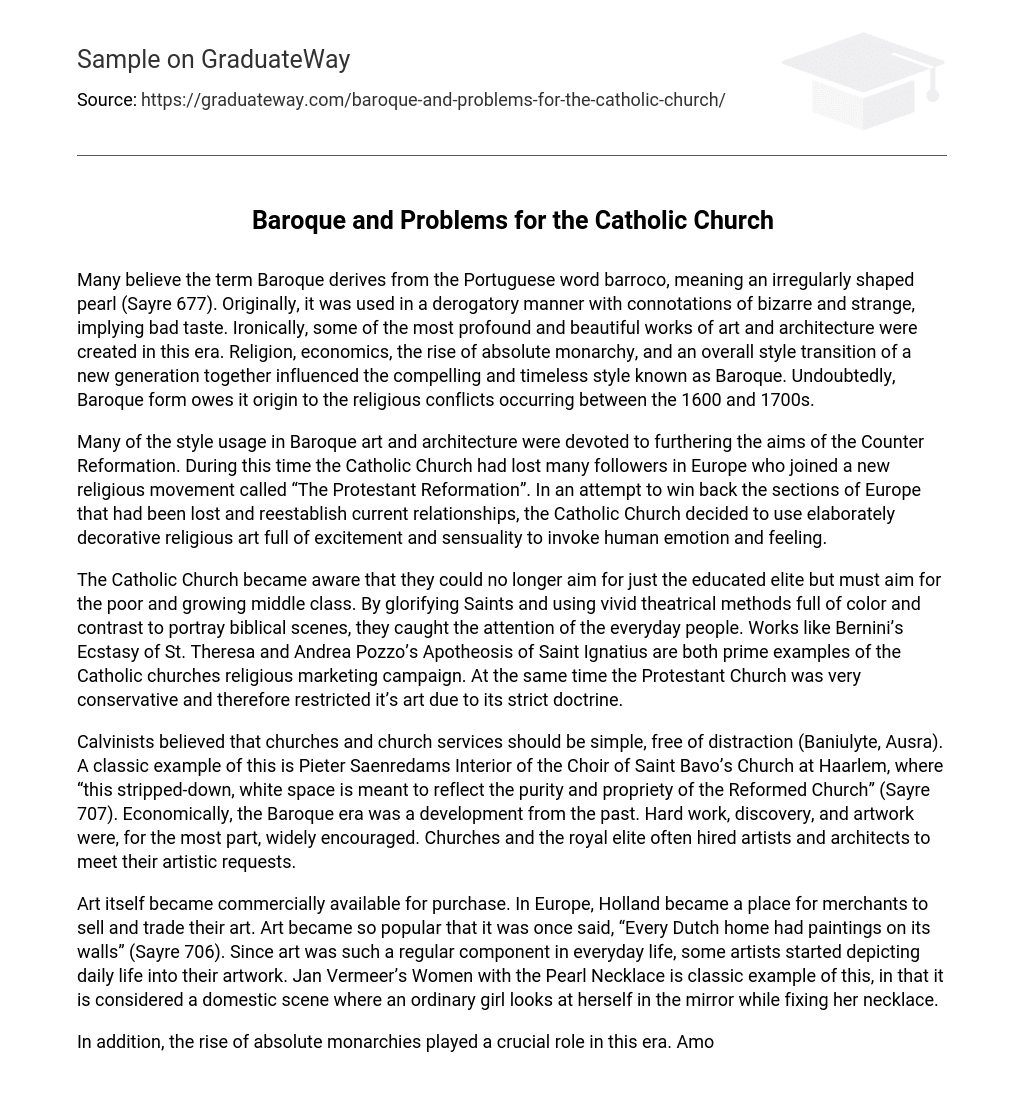The term Baroque, derived from the Portuguese word barroco, meaning an irregularly shaped pearl (Sayre 677), was initially used negatively with connotations of being bizarre and strange, indicating poor taste. However, paradoxically, this period gave birth to some of the most profound and exquisite works of art and architecture. The captivating and timeless style known as Baroque was influenced by religion, economics, the rise of absolute monarchy, and a general shift in artistic preferences among a new generation. Undeniably, the emergence of the Baroque form can be attributed to religious conflicts occurring between the 1600s and 1700s.
The style usage in Baroque art and architecture aimed to serve the Counter Reformation, as the Catholic Church sought to regain the followers it had lost in Europe to the Protestant Reformation. To win back the regions that had been lost and restore existing relationships, the Catholic Church employed highly ornate religious art that evoked human emotion and sensuality.
The Catholic Church shifted its focus from targeting the educated elite to reaching out to the poor and growing middle class. To capture the attention of everyday people, they glorified Saints and employed vibrant theatrical techniques that emphasized color and contrast in their depiction of biblical scenes. Examples of this religious marketing campaign by the Catholic Church include Bernini’s Ecstasy of St. Theresa and Andrea Pozzo’s Apotheosis of Saint Ignatius. In contrast, the Protestant Church, being more conservative, constrained its art production due to its strict doctrine.
Calvinists, who believed in simplicity and lack of distraction in churches and church services (Baniulyte, Ausra), can be seen in Pieter Saenredam’s Interior of the Choir of Saint Bavo’s Church at Haarlem. The minimalist and white space of the artwork represents the purity and appropriateness of the Reformed Church (Sayre 707). In the Baroque era, there was an economic advancement. Hard work, exploration, and artistic endeavors were generally promoted. Artists and architects were frequently employed by churches and the royal elite to fulfill their artistic needs.
Art was made available for purchase commercially, and Holland in Europe emerged as a hub for merchants to sell and trade their artwork. The popularity of art grew to the extent that it was noted that “Every Dutch home had paintings on its walls”(Sayre 706). Consequently, artists began incorporating daily life into their works. One such example is Jan Vermeer’s Women with the Pearl Necklace, which portrays a domestic scene featuring a regular girl gazing at herself in the mirror while adjusting her necklace.
During the Baroque era, powerful rulers such as Phillip II of Spain, Frederick the Great of Germany, and Peter the Great of Russia emerged alongside flourishing absolute monarchies. However, Louis XIV distinguished himself by seeking to showcase his centralized state’s power and greatness. This led to the creation of splendid baroque palaces like Versailles’ Royal Palace and Gardens. Louis XIV’s wariness towards both nobility and commoners can be traced back to an event during the rebellions in 1649 (Britannica).
Louis XIV, also referred to as the “Sun King”, exercised complete dominion over his residence and ensured that all revolved around him. He played a vital role in the expansion that led to the creation of the impressive edifice we witness today. To build this extraordinary masterpiece in the Baroque fashion, he commissioned architect Louis Le Vau and artist Charles Le Brun. The palace aimed to serve as a magnificent embodiment of the King’s authority, surpassing anything comparable in magnitude and grandeur of its time.
Despite his self-obsession and vanity, Louis XIV was a great patron of the arts. Fortunately, his personal tastes encompassed both the balance and harmony of classical art as well as the drama and exuberance of the Baroque period (Sayre 732). One of his preferred artists was Peter Paul Rubens, a Flemish painter. The painting entitled The Arrival and Reception of Marie de’ Medici at Marseilles is a prime example of Rubens’ dramatic Baroque style, which showcases his distinctively fleshy bodies. Furthermore, this era marked a shift from the Renaissance in terms of style and way of life.
The art of the Renaissance emphasized clarity and realism. However, it did not fully capture human emotions. On the other hand, Baroque art dedicated more attention to portraying emotions. This shift in focus led to an emergence of solidity and weightiness in Italian paintings. Caravaggio and Annibale Carracci were prominent figures who exemplified this new style. In terms of architecture, Baroque buildings were known for their spacious, sensual, and extravagant designs. Throughout this era, innovative techniques were utilized in the creation of these structures.
Levy states that artists like Bernini achieved a revolutionary breakthrough in sculpture, giving the illusion that stone could bleed. The Baroque period witnessed unprecedented influential and emotionally powerful artwork. Religion and economics were among the key factors shaping the familiar Baroque style we know today. Undoubtedly, both art and architecture techniques from this era still have a profound impact on contemporary visual art.
Works Cited
Aušra Baniulytė wrote a scholarly article titled “Italian Intrigue In The Baltic: Myth, Faith, And Politics In The Age Of Baroque.” This article was published in 2012 in the Journal of Early Modern History and can be found in the Academic Search Complete database. It explores the relationship between myth, faith, and politics during the Baroque era in the Baltic region.
The online publication of Encyclopædia Britannica mentions the term “Baroque period”. The source, published by Encyclopædia Britannica Inc. in 2013, has been available on the web since February 2nd, 2013.
Levy, Evonne. “Repeat Performances: Bernini, The Portrait And Its Copy.” Sculpture Journal 20.2 (2011): 239-249. Art & Architecture Complete. Web. 4 Feb. 2013.
The source of the text is “Sayre, Henery M. The Humanities: Culture, Continuity and Change, Book 4.” It is a webpage that was accessed on February 2, 2013.





